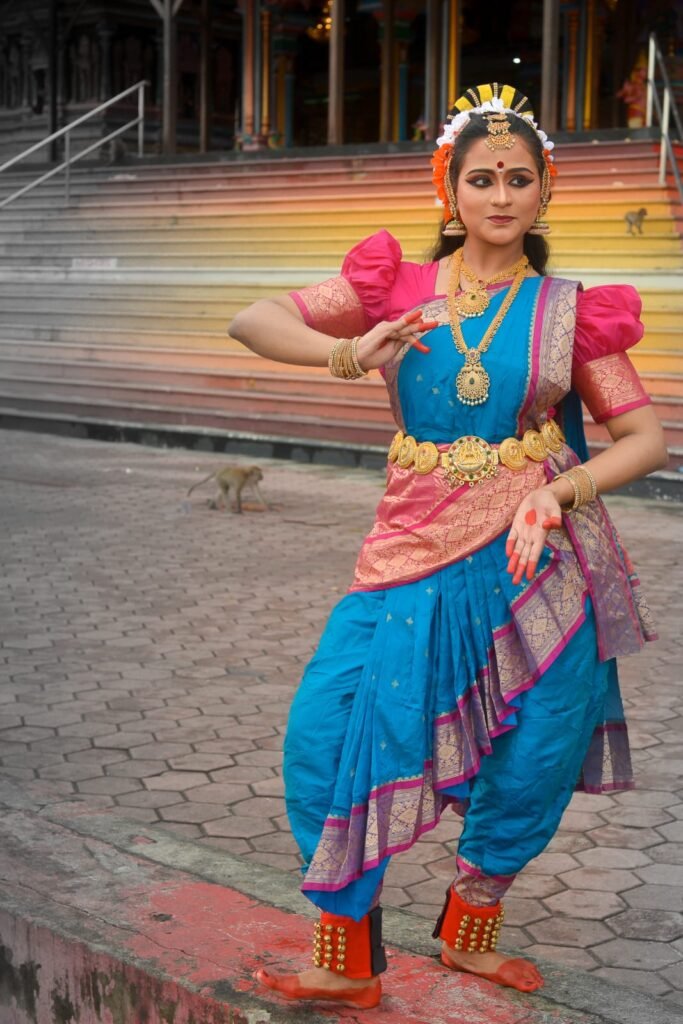Dance, Drama, and Divine Grace
Kuchipudi—a jewel in the crown of Andhra Pradesh—continues to enchant audiences across the globe with its dynamic fusion of movement, melody, and narrative. More than just a classical dance form, Kuchipudi is a living, breathing expression of devotion, storytelling, and tradition, rooted in ancient scriptures and enriched by centuries of artistic evolution.
Sacred Origins: Where Dance Became Drama
Kuchipudi finds its origins in the eponymous village of Kuchipudi in Andhra Pradesh. It draws heavily from the Natya Shastra, the foundational Sanskrit treatise on performing arts. While dance and drama had been practiced in this region for centuries, it was the 17th-century visionary Siddhendra Yogi who gave Kuchipudi its distinctive structure. A devout Vaishnava poet and reformer, Siddhendra Yogi composed Bhama Kalapam, a seminal dance-drama that centered on the character of Satyabhama, the consort of Lord Krishna. This work laid the foundation for a unique performance tradition that seamlessly blended storytelling, music, movement, and spirituality.

The Soul of Kuchipudi: A Confluence of Art Forms
Kuchipudi stands out among Indian classical dance forms for its theatrical essence. A performance typically begins with an invocation and a short introduction by the dancer, who often reveals the characters and theme. The sequence progresses through nritta (pure dance), nritya (expressive dance), and natya (drama), reflecting the classical structure outlined in the Natya Shastra. What sets Kuchipudi apart is its use of spoken dialogue and lyrical recitation during the performance, often delivered by the dancers themselves. This unique integration of dance and drama imbues the form with vibrancy and versatility, making every performance a multidimensional experience.
Visual and Musical Grandeur
Kuchipudi’s visual appeal lies in its vibrant, carefully crafted costumes and dynamic expressions. Female dancers wear colorful sarees stitched in a style that allows freedom of movement, featuring a pleated fan that opens gracefully with each bend and jump. Male performers don traditional dhotis and angavastrams. The aesthetic is further enhanced by ornate temple jewelry, expressive eye makeup, and symbolic adornments. Musically, Kuchipudi draws from the Carnatic tradition, employing instruments like the mridangam, violin, veena, flute, and tambura. The music not only complements the dancer’s movements but also adds emotional texture to the narrative.
From Temples to Global Stages
Historically performed by male Brahmins as a form of religious offering in temple courtyards, Kuchipudi has gradually embraced a more inclusive identity. Over the last century, women began learning and performing the dance, and today they represent a significant portion of Kuchipudi artists. The dance form has moved from the temple to the theatre, from rural Andhra to urban India, and from national stages to international festivals, all while retaining its traditional core. Contemporary themes and modern productions have also entered the repertoire, expanding its audience and relevance without diluting its classical integrity.
At Sri Radha Krishna Kalakshetra, we honor the legacy of Kuchipudi while guiding it toward a vibrant future. Our structured curriculum is designed to provide holistic training in all aspects of the art—rhythmic footwork, expressive storytelling, vocal delivery, and dramatic presence. Guided by seasoned gurus, students are immersed in an environment of discipline, devotion, and creativity. Workshops, performances, and cultural outreach are an integral part of the learning journey, helping students evolve into confident, expressive, and culturally grounded artists.
Join us in celebrating the magic of Kuchipudi—where the rhythm of the feet, the melody of the voice, and the spark of devotion come together to tell timeless tales.

Sri Radhakrishna Kalakshetra, established in 1998, is a premier institute dedicated to preserving and promoting Indian classical dance and music through disciplined training, cultural programs, and global performances.
All Rights Reserved © 2025 | Sri Radhakrishna Kalakshetra